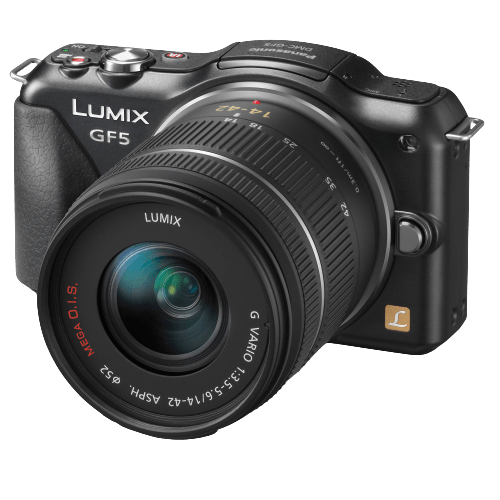Panasonic Lumix DMC GF5 Specs and Scores

Our Panasonic Lumix DMC GF5 camera receives a score of 45/100. Announced in April 2012, this mirrorless camera has been in the market for quite some time. Priced at $599 upon release, the camera measures 108 x 67 x 37mm and weighs 267g (0.59lbs). Considering its age, the specifications are decent, but they may not fare well against newer cameras with more advanced features. Despite this, the Lumix DMC GF5 still offers a solid performance in certain situations.
Panasonic Lumix DMC GF5 Overview and Optics
The Panasonic Lumix DMC GF5 receives an optics score of 44 out of 100. With 12.1 megapixels, a shooting speed of 4 frames per second, and a CMOS sensor, the camera provides decent image quality. Its Venus Engine FHD processor ensures fast image processing, while the DXOMARK score of 50 for the sensor shows that it performs well in various lighting conditions.
The GF5 features a Micro Four Thirds sensor size and a Micro 4/3 lens mount, making it compatible with a wide range of lenses. The inclusion of image stabilization helps reduce camera shake, resulting in sharper images. The 4:3 aspect ratio is suitable for both landscape and portrait photography.
Despite these features, the GF5’s optics specifications are not as competitive in today’s market, with many cameras offering higher megapixels, faster shooting speeds, and better sensor performance. Nonetheless, the Panasonic Lumix DMC GF5 is a viable option for those seeking a compact camera with decent image quality and lens compatibility.
Panasonic Lumix DMC GF5 Video Performance
The Panasonic Lumix DMC GF5 has a video score of 43 out of 100. Its maximum video resolution is Full HD, with dimensions of 1920 x 1080 pixels. The camera supports a maximum video frame rate of 30 frames per second. However, it lacks built-in time-lapse functionality.
In today’s market, the Lumix DMC GF5’s video capabilities are average. Many modern cameras offer higher resolutions like 4K and faster frame rates, which provide smoother and more detailed footage. Additionally, time-lapse functionality is a popular feature that this camera does not have.
The Lumix DMC GF5’s video performance is decent for casual users but falls short for those seeking advanced video features. Its score of 43 reflects its limitations compared to newer cameras with more advanced video capabilities.
Panasonic Lumix DMC GF5 Features and Benefits
The Panasonic Lumix DMC GF5 features a score of 54/100, which gives us insight into its capabilities. With a 3-inch screen size and a resolution of 920,000 dots, the camera offers a touchscreen interface but lacks a flip screen. Additionally, it does not include GPS, WIFI, or Bluetooth functionalities.
Comparing these specifications to other cameras in today’s market, it is evident that the Lumix DMC GF5 falls short in certain aspects. Many contemporary cameras now come with WIFI and Bluetooth capabilities, making it easier for users to transfer photos and videos wirelessly. Furthermore, the absence of a flip screen limits the camera’s versatility for various shooting angles.
Taking these factors into consideration, the Panasonic Lumix DMC GF5 offers basic features and could benefit from improvements to keep up with current market trends and demands.
Panasonic Lumix DMC GF5 Storage and Battery
The Panasonic Lumix DMC GF5 receives a storage and battery score of 21/100. The camera has one memory card slot, accepting SD, SDHC, and SDXC cards. However, the battery life is limited to 360 shots per charge, using a DMW-BLE9E battery. Additionally, the camera does not support USB charging.
In today’s market, the storage capacity is standard with the single memory card slot. However, the battery life falls short compared to other cameras, which may offer longer-lasting batteries and USB charging capabilities. This could be a drawback for users who require extended shooting time without the need to constantly change or recharge batteries.
Taking these factors into account, the Panasonic Lumix DMC GF5’s storage and battery specifications are not as competitive as other options in the market.
